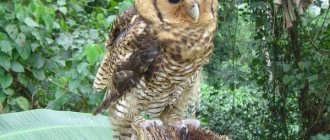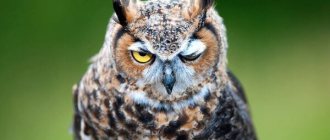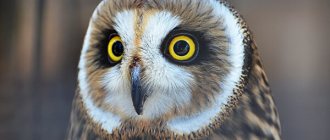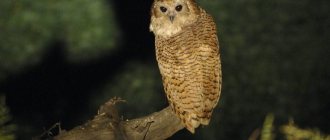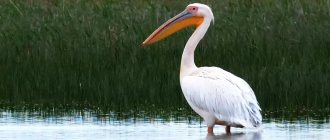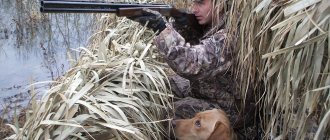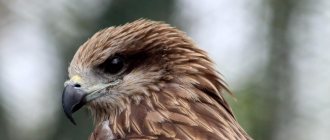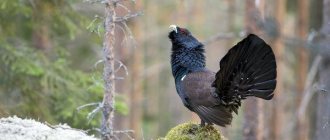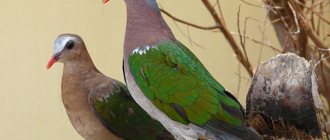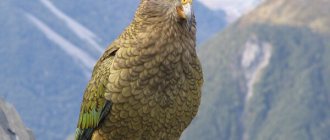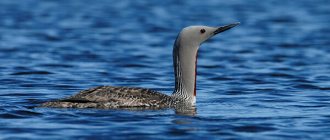The fish owl forms a separate species in the owl family. At the moment, the population of these birds is so insignificant that this species is under threat of complete extinction.
The fish eagle owl is an inhabitant of a fairly large region: Japan, Korea, China, Primorye, Amur Region, the Kuril Islands and Sakhalin. The bird prefers to settle in forests along river banks. During the cold season, this predator flies to non-freezing areas of water bodies. He waits out the winter on river rifts, where, despite the fast current, there is always his favorite food - fish.
Fish owl (Bubo blakistoni).
Appearance of a fish owl
The appearance of the fish eagle owl is slightly different from the ordinary one. The plumage is brown in color with pockmarked spots all over the body. There is a small white spot between the throat and body. In terms of its dimensions, the fish eagle owl is not inferior to its relatives; its body length can reach 75 centimeters, and its weight can reach 4 kilograms. The fish owl's eyes are bright yellow and have excellent vision. The beak is curved and wide. There are fluffy feather ears on the head. A distinctive feature of the fish owl is the lack of feathering on its legs.
Eagle owl behavior and nutrition
It is not difficult to guess that the fish eagle owl feeds on fish. The bird preys on such fish species as pike, burbot, catfish, trout and salmon. A dexterous eagle owl can catch prey equal in weight to itself. Representatives of this species catch rodents, frogs and small birds. The eagle owl does not disdain carrion and often ruins the traps of hunters.
Bird hunting happens like this. The fish owl sits on a high place and waits patiently. When a fish appears at the surface of the water, the predator quickly dives and grabs it with its sharp claws.
The fish owl is a fast predator.
The fish eagle owl is not afraid of frost and hunts its prey near the wormwood. The predator does not have a protective, water-repellent layer of fat, so the feathers can get wet. Under the influence of cold, the bird's plumage becomes covered with a crust of ice. In this state, the eagle owl is unable not only to take off, but also to move. In this case, the bird faces death.
Although the fish owl can catch prey all day, it is most active in the early morning or late evening. The predator guards its territory and vigilantly monitors that no stranger gets into it.
Habitats
The fish owl was unknown for quite a long time. Small notes about him appeared only in the 70s. The fish owl is rare for ornithologists due to its habitat. It was possible to meet this species in very remote regions of Russia and on the islands of the Japanese archipelago. Sometimes the bird lives in Manchuria and North Korea. In Russia, small populations are located in Primorye, Sakhalin and Magadan.
As habitats, they prefer forest areas near ice-free, fast-flowing rivers. In nature, the fish eagle owl lives up to 20 years, and in captivity it can live more than 40 years.
Fish eagle owl
Kingdom: animals (Animalia). Phylum: chordates (Chordata). Class: birds (Aves). Order: owls (Strigiformes). Family: owls (Strigidae). Genus: eagle owls (Bubo). Species: fish owl (Bubo blakistoni). Subspecies: continental (doerriesi), island (blakistoni).
Where does he live?
The fish eagle owl lives in the forests of the Far East, in the Amur and Primorye regions, on the Kuril Islands and Sakhalin Island. The continental subspecies is characteristic of the southern part of the Ussuri, as well as the Khabarovsk and Primorsky territories. The island subspecies is found only on the southern coast of Sakhalin Island and on Kushnair Island, outside the Russian Federation - in Japan, Manchuria, and northern Korea. The favorite habitats of fish owls are the floodplains of rivers rich in fish.
External signs
The fish owl is not only the largest eagle owl, but also one of the strongest and most impressive members of its family. Its body length is on average about 70 cm, its wingspan is 180–190 cm, and its weight reaches 4 kg. It has a dense, slightly massive build, long wings and a slightly rounded tail. Wide feather “ears” are clearly visible on the head. The color of the plumage is brownish or gray with dark spots or streaks.
Lifestyle
The fish owl leads a sedentary lifestyle. Only times of famine can force him to leave his usual habitat - then he goes in search of places richer in food resources. Eagle owls are active not only at twilight or at night, but also during the day. A favorite delicacy is fish from the salmon family. When hundreds of spawning fish rise up the northern rivers, the happiest time comes for fish owls. Birds have their own hunting tricks. They can circle over a body of water, looking for a future victim from the air, walk in shallow water or hide in ambush. In addition to fish, eagle owls hunt rodents, amphibians, reptiles, eat crayfish, can attack other birds and do not disdain carrion, especially in the winter season.
Sexual maturity occurs in the third year of life. The mating season begins quite early, usually in February - March. Spacious hollows in old poplars, elms or oaks located near water bodies are optimal for arranging a nest for an eagle owl. The female lays one to three eggs and begins to incubate the clutch. For 35 days (the average incubation period), the male will bring her, and later the chicks that are born, the necessary food. In order to fledge and take wing, the chicks need about 35–40 days, but even after this time, the parents continue to feed and care for the offspring for several months.
Fish owls have few natural enemies. There is evidence of attacks on birds by the common lynx and the Himalayan bear.
The fish owl occupies a special place in the culture of ancient peoples: the Ainu, the oldest population of the Japanese Islands, as well as the Evens, the Siberian Tungus-Manchu people. The Ainu revere this eagle owl as a deity capable of warning people about the dangers that threaten them and protecting them from enemies. Akan National Park is located on the island of Hokkaido. On the shore of the lake there is a small village of AinuKotan, whose patron is the fish owl.
In the Red Book of Russia
The fish or Far Eastern eagle owl is one of the rarest and most vulnerable birds in Russia. Changes in the hydrological regime of reservoirs, industrial development of virgin corners of nature, pollution of rivers with industrial waste, deterioration of the food supply - all this has a sharply negative impact on the number of fish eagle owls. In addition, in Russia, birds are destroyed by poachers and end up in nets set for salmon fish. Eagle owls die in traps and traps prepared for fur-bearing animals. After all, raw meat, which is often placed there as bait, is very attractive to birds, especially in the winter season. The fish eagle owl is included in the International Red List with the protection category EN - endangered.
Other types of owls:
Cave owl Snowy owl Elf owl
Feeding and searching for prey
Like most members of the owl family, fish owls become more active as night falls. As a rule, their main prey is fish. Birds may sometimes consume amphibians. The hunting grounds of fish eagle owls are marked by paths and holes that this large bird makes on the way to the river. Birds may lurk in the snow, waiting for an opportunity to attack prey.
During severe frosts, fish eagle owls flock to unfrozen sources. Thus, aggregations of fish eagle owls can form, which is very rare. The common fish eagle owl is a solitary animal and always hunts for food alone, defending the chosen territory from fellow competitors.
Fish eagle owls are sedentary birds and rarely leave their nesting site. They are forced to wander only by the lack of food in their chosen area.
The eagle owl's favorite fish are salmon, trout and pike. They hunt crayfish, frogs and minks. Due to its large size, it can attack other birds. Sometimes it feeds on carrion.
Magadan Region
Status: I category. A rare species with critically low numbers.
Spreading
Within the Magadan region, the fish eagle owl was noted on the river. Buxendya, Yama, Nayahan, but these encounters refer to single individuals in late summer, autumn or winter. Currently, this species sustainably lives only in the valley of the river. Chelomdzha.
Number
The total number of the species within its range apparently does not exceed 300-500 pairs. In the Chelomdzhi Valley, each pair of fish eagle owls occupies a section of the valley about 8-12 km long. Hence, the potential abundance of the species in the river basins. Chelomdzha and Taui are estimated at 15-17 pairs. In reality, it is 6-8 pairs, since in the Tauya basin this bird has completely disappeared, and in the Chelomdzhi valley it is gradually declining.
Source: Red Book of the Magadan Region: Rare and endangered species of plants and animals. Chereshnev I.A., Andreev A.V., Berman D.I., Dokuchaev N.E., Kashin V.A., Polezhaev A.N. (2008) Administration of the Magadan Region, Department of Natural Resources; Institute of Biological Problems of the North, Far Eastern Branch of the Russian Academy of Sciences
Reproduction
Fish owls become sexually mature in the third year of life. The mating season begins in frosty February. During this period, the male chooses his site and informs other representatives with a loud cry early in the morning or with the onset of evening twilight. From these sounds, the female learns that there is a worthy male for procreation.
Fish eagle owls take special care of the chosen female. Each male must demonstrate the ability to obtain prey to prove his intentions. It looks like this: while the male waits for prey by the river, the female sits on a branch and watches how the future father of the offspring copes.
The resulting pairs make nests in the gorges of old trees. With the onset of spring, the female lays two eggs. Incubation occurs within a month. The female does not leave her eggs, as the cold climate does not allow this. If the female separates, her offspring run the risk of dying without even hatching. As a rule, only one chick is born from two eggs. For two months, the cubs are looked after by their parents. In the third month, the little chicks acquire the ability to fly independently. They leave the nest only after a few months. Sometimes even one-year-old fish owls can fly to their parents and beg for food. Many children stay with their parents for two years, learning to fish from them.
Fish owl chicks
Amur region
Status: I category. An endangered resident species on the northwestern border of its range.
Spreading
In the Amur region this is an extremely locally widespread species. For the first time in the river basin. Selemdzhi noted him by his voice.
Visually, one individual was discovered on December 17, 2001 in the protective zone of the Norsky Nature Reserve near the mouth of the river. Meun on the river Nora; February 20, 2002 at the mouth of the river. Meun observed three birds, and on March 12 of the same year a nest was found in the area.
In 2002-2004 a fish owl was seen on the river. Selemdzha in the area of the Dvadtsatikha channel, 70 km from the mouth of the river. Meun, and at the Ozerny spring (the right tributary of the Burunda 50-60 km above its mouth). In addition, the fish owl may live in the middle reaches of the river. Dep.
In January 2010, a very large owl, which could be classified as a fish eagle owl, stayed near a hole in the middle reaches of the river. Tynda.
Number
In the interfluve of the middle reaches of the Selemdzha and its right tributary, the Nora, there is a sedentary settlement of the fish owl, consisting of five to six nesting pairs. Abundances at other potential loci are unknown.
Source: Red Book of the Amur Region: Rare and endangered species of animals, plants and mushrooms / Rep. ed. Kozhemyako O.N. et al. (2009). Blagoveshchensk: BSPU Publishing House
Characteristics
The plumage of a fish owl is not capable of accumulating the fatty layer that protects birds from water, which is why wet feathers can freeze, preventing the poor birds from moving. This can be recognized by the characteristic noise when the bird flies over long distances.
An amazing feature of the fish owl is its tendency to obesity. In preparation for frost, the fish owl accumulates a lot of subcutaneous fat, which can reach up to two centimeters in length.
When danger arises, the fish owl fluffs up its plumage, which makes it many times larger, thereby frightening a potential enemy.
Sakhalin region
Status: I category. A rare species with a local distribution and declining numbers.
Spreading
Nesting range: Sakhalin and the southern Kuril Islands. On Sakhalin, the fish eagle owl is widespread in the southern and central regions, but extremely sporadically. It was noted on the east coast near the mouth of the river. Naiba, in the valleys of the Makarovka and Lazovaya rivers, on the southwestern coast of the Krillon Peninsula, in particular in the valley of the river. Kuznetsovka, in the river basin Tym. In the southern Kuril Islands, the eagle owl reliably nests on Kunashir; it was observed in August on Shikotan. The nature of the stay on Iturup requires clarification.
Number
There is no information on the number of eagle owls on Sakhalin; Solitary birds were encountered. In the south of Kunashir in 1962 - 1963. One pair nested on rivers 3-5 km long. The total number of eagle owls, according to 1987 data, was 18 breeding pairs.
Source: Red Book of the Sakhalin Region: Animals. Rep. ed. Efanov (2016) Moscow, Buki Vedi
